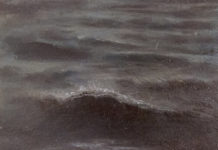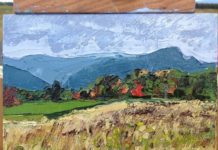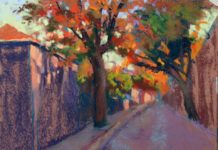
Colorado has some beautiful views — some lush views — but one reason the Rocky Mountains are awe-inspiring is their uncompromising ruggedness. Greg Summers seems to embrace that.

Summers painting “Abandoned at LaSauses.” The artist had ripped his bicep muscle the day before, thus the makeshift sling. The red velvet tacked to the back of his canvas is to prevent light from shining through.
The Kansas painter grew up in the picturesque Flint Hills, and if he’s driving to Colorado he could stop at Estes Park or Keystone or any number of spots with jaw-dropping vistas, but Summers’s favorite spot is the high-plains plateau of San Luis Valley in south-central Colorado, the headwaters of the Rio Grande. “The terrain is wonderful,” he gushes. “The colors are particularly beautiful in the fall and winter. I’ve grown to love the grays of the winter. It’s very compelling. There are dried-up rivers and abandoned buildings — there’s something about falling-down dwellings that really captures people’s attention.”

“Little Squall in Mogote,” by R. Gregory Summers, oil, 22 x 28 in.

Painting “Little Squall in Mogote.” “I did pull down that lightning rod of an umbrella soon after that,” says Summers.
Summers discovered the dry valley because his mentor, Rick Howell, lived in the area. Summers says he often gets three paintings done per day when he visits. “I love the morning — I like to get out at sunrise, jump up and paint, and spend a couple of hours on a piece,” he says. “I get everything blocked in in 30 minutes, then get to the good stuff. I do one after lunch, and then take a break, and try another painting at the end of the afternoon. There in the valley, things are so close, you can just turn around and find something else worth painting. I’d like to try setting up several easels in different directions and try to paint like that.”

“Stepping Across Borders,” by R. Gregory Summers, oil, 20 x 30 in.
The artist avoids towns of significant size, finding inexpensive rooms along the way in which to sleep. He says he would camp, but he finds that one can spend too much time and energy on the camping component, taking away resources for the painting part.

“Old LaVeta Pass,” by R. Gregory Summers, oil, 20 x 24 in.
Even though much of the San Luis Valley is desert, it can get quite cold there in the winter. This does not faze Summers. “My limits? I don’t know them yet,” he says. “I really don’t like the cold, but I’ve painted in sub-zero weather. I wear mittens, not gloves, to keep things loose. I don’t spend a lot of time on a painting, and I dress appropriately. I move around a lot and try not to be out there long enough to get cold.”

A typical view in the San Luis Valley
Finding the bright side of the freezing wind, he adds, “There are no bugs.”




